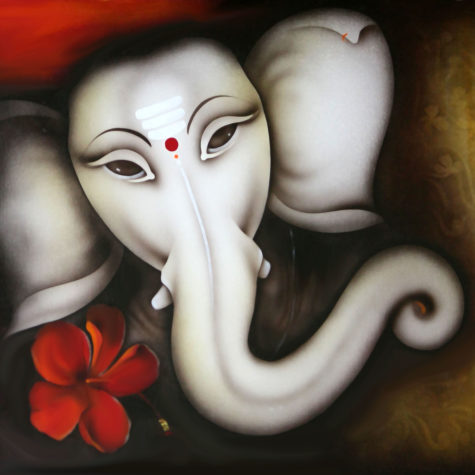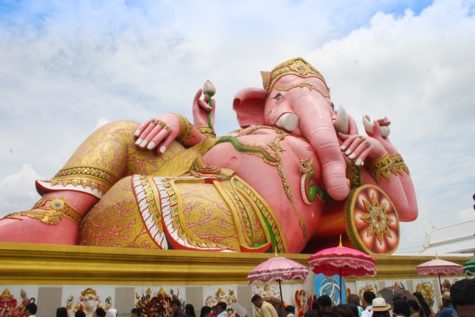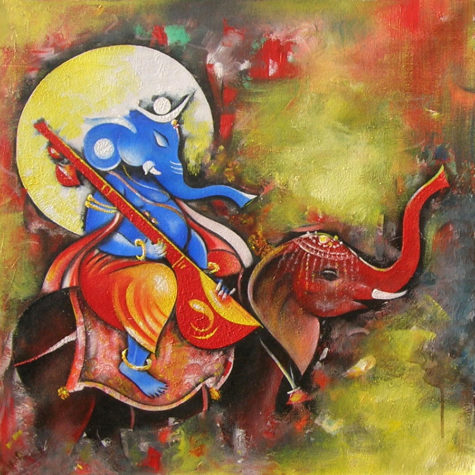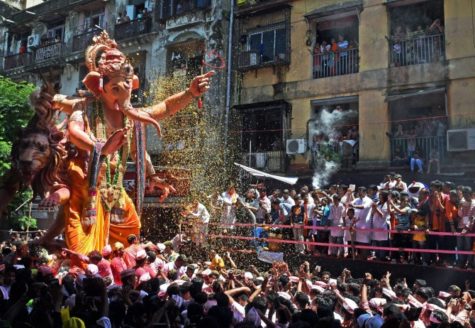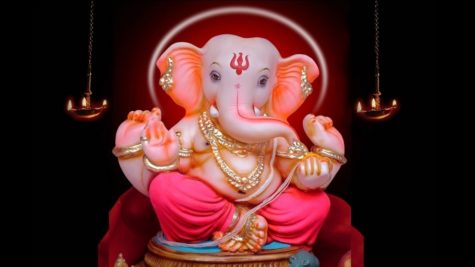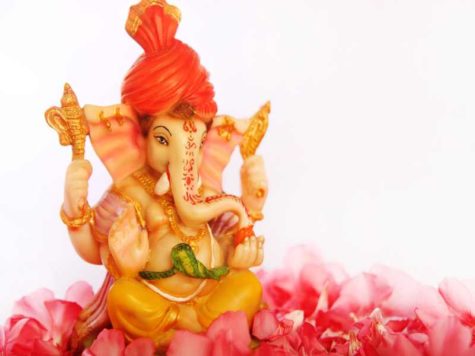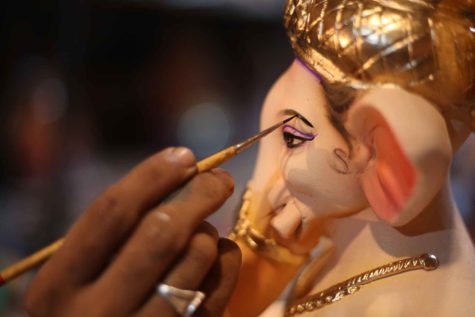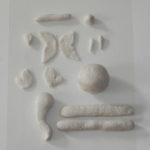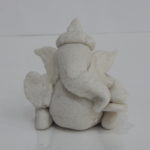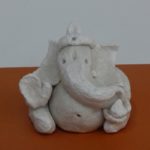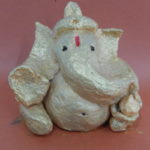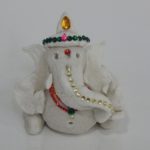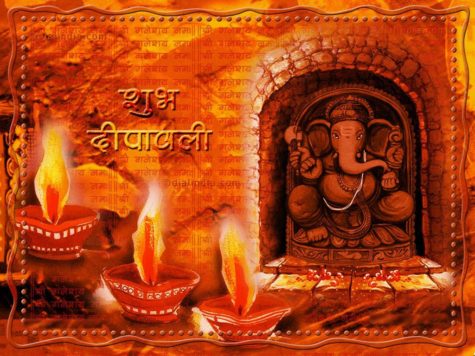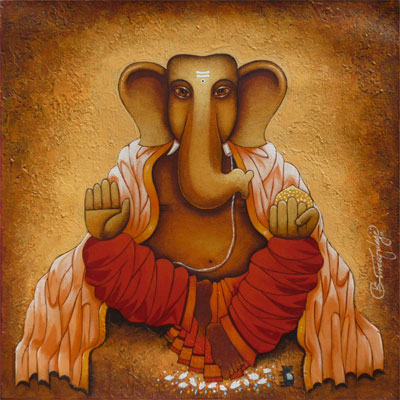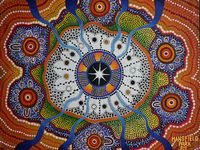Invoking Ganesh
A Small Poem
Other Ganesh Mantras
- Aum Shri Ganeshaya Namah.
This is the mantra of invocation, adoration and worship. It means ” Praise to Lord Ganesha“. It is repeated at the beginning of religious ceremonies and mantra recitation to invoke Ganesha’s blessings for the auspicious beginning of a task, project, change of life, community undertaking or simply to offer Him praise.
This mantra is usually taught to children for their good education. It increases their memory power, and they become successful in their examinations. Of course, people of any age may use this mantra when taking courses in a school or university, and for success in attaining their degree.
- Aum Gum Ganapataye Namaha.
This is Lord Ganesha’s mula (“root”) mantra. It is also known as His bija mantra, for it combines Ganesha’s bija (“seed”) sound, “gum,” with the phrase, “Praise be to Ganapati.” This is a mantra from Ganapati Upanishad. One may always use it before beginning a journey, new career or job, or before entering into any new contract or business so that impediments are removed and your endeavor may be crowned with success.
- Aum Vakratundaya Hum.
This is a very powerful mantra. When something is not working properly, individually or universally, nationally or internationally, or when the minds of the people turn crooked, negative, depressed or discouraged, the attention of Ganesha may be drawn by this mantra to straighten their ways. The HUM symbolizes “Delay no more, my Lord, in straightening the paths of the crooked-minded ones.”
In addition, this mantra could also be used for healing any spinal deficiency, such as curvature of the spine or curved limbs. Dedicate 1,008 repetitions of this holy word to straighten and heal such deficiencies.
- Aum Kshipra Prasadaya Namah.
Kshipra means instantaneous. If some danger or negative energy is coming your way and you don’t know how to get rid of that trouble, with true devotion, practice this mantra for quick blessing and purification of one’s aura.
- Aum Shrim Hrim Klim Glaum Gam Ganapataye Vara Varada Sarva Janamme Vashamanaya Svaha.
There are several bija (seed) mantras in this mantra . Among other things, it signals, “Shower Your blessings, O Lord. I offer my ego as an oblation.”
- Aum Sumukhaya Namah.
This mantra has a lot of meaning, but to make it simple, it means you will be always very beautiful in soul, in spirit,in face, everything. By meditating on this mantra, very pleasing manners and a beauty comes on you. Along with that comes peace, which constantly dances in your eyes; and the words you speak are all filled with that power of love.
- Aum Ekadantaya Namah.
Ekadanta refers to one tusk in the elephant face, which means God broke the duality and made you to have a one-pointed mind. Whoever has that oneness of mind and single-minded devotion will achieve everything.
- Aum Kapilaya Namah.
Kapila (red) means that you are able to give color therapy. You are able to create colors around yourself and around others, bathe them in that color and heal them. As per the mantra you create, so will you create the colors. Another meaning is “wish cow,” the “cow of plenty.” It means that whatever you wish, that comes true. There is a wish-cow inside you. Whatever you wish, especially for healing others, comes true immediately.
- Aum Gajakarnikaya Namah.
The ears of Ganesha, the elephant, are constant fanning, which means people may talk a lot,but you are not receiving inside anything other than that which is important.It also means that you can sit anywhere and tune this cosmic television (the body) with seven channels (chakras) and all 72,000 nadis, to any loka and be able to hear ancestors, angels, the voice of God or the voice of prophets. That kind of inner ear you will develop through this mantra.
- Aum Lambodaraya Namah.
This means you feel that you are this universe. It means that all the universes are within you. Like an entire tree is in the seed, the whole universe is in the sound of creation, which is Aum, and that Aum consciousness in you makes you feel that you are the universe. Therefore, if you say, realizing the oneness with the universe, “shanti to the world” every day, then the grace of God will come and there will be world peace, universal peace. It is the universes within Aum and Aum within you.
- Aum Vikataya Namah.
This means realizing this world as a dream or a drama. When you are in that high consciousness, this whole world looks like a dream. All of us have taken a role. We have to play our role in life as wife or husband or children or citizens, all consistent with the role we have taken.
When an actor bitten by a sponge cobra that is brought on the stage falls, the entire audience cries; but that boy who has fallen knows it was not a real cobra and he is not dead. Life is a drama –definitely life in this material world, this physical world of ego, is a drama. But inside, like the boy on the stage who is quite happy knowing that he didn’t die by the bite of the sponge cobra, like that, the truth never dies in us; it is immortal. So everything else you consider as drama. That consciousness comes to you by knowing this mantra.
- Aum Vighna Nashanaya Namah.
This mantra invokes the Lord Ganesha to remove every impediment in your life and in your works. By constant meditation on this mantra, all obstacles and blocked energy in your physical and astral bodies are released.
- Aum Vinayakaya Namah.
Vinayaka is the name of Ganesha in the golden age. So by realizing this mantra, your life will have a golden age. In your office, in your work, you’ll be the boss. Vinayaka means something under control. Vinayaka means the Lord of problems.
- Aum Ganadhyakshaya Namah.
This mantra is so important. Suppose you have a group, a country, neighbors, or any kind of group therapy, group healing or a whole country needing healing, then you have to bring that entire group to your mind’s arena and say this mantra. A group healing takes place by this mantra.
- Aum Bhalachandraya Namah.
In Sanskrit, bhala means the forehead center. Chandra means the crescent moon. Bhalachandra means that chakra from where the nectar drips. That is the secret of all healing. It is to feel yourself as Siva, identifying yourself with the Truth and feeling constantly that you are carrying the crescent moon, the symbol of growth and nectar and peace.
from Loving Ganesa
by Satguru Sivaya Subramuniyaswami
The Ganesh Chaturthi Festival
From the Pagan Calendar, we have this great info about the Ganesh Chaturthi:
Vinayaka Chaturthi – also known as Ganesh Chaturthi – is a Hindu holiday festival that is observed on on the fourth waxing moon day during the month of Bhadrapada. This is around August or September on the Gregorian Calendar. The purpose of this festival is to honor the very popular Hindu God Ganesha, also known as Vinayaka.
- Dates vary from year to year.
- In 2018, the festival runs from September 12 thru Sept 23.
The concept of Ganesh Chaturthi is that Ganesha comes to the home of his devotees on Ganesh Chaturthi day. He brings auspiciousness, hope, success and happiness to all homes. During His brief stay, He removes all obstacles. While returning He takes with him all problems and unhappiness.
Vinayaka Chaturthi is a festival that allows people to call on the power of Ganesh and to receive help from him in removing all of the obstacles that hinder their spiritual or mental path. It is also a time to ask for help in developing spiritual strength and resolve. It is a festival of great hope, joy and celebration that can be enjoyed by everyone regardless of class or wealth.
This remains one of the most widely celebrated festivals in the Country, partly because Ganesh is one of the most popular deities for worship. Ganesha, the elephant-headed son of Shiva and Parvati, is the supreme god of knowledge, wisdom, prosperity and good fortune. He is the Lord who is first worshiped before any holy occasion or puja.
His blessings are often invoked at religious ceremonies as he is the one who can remove all obstacles to success, particularly when people are starting a new business or enterprise. Ganesh is known as the giver of fortune and one who can help to avoid natural calamities. Ganesh is also the patron god of travelling.
Lord Vinayaka is revered as the preserver of all good things and prevents Vigna (meaning obstruction/bad omen). His motto is Shubh-Laabh (good prospect and good prosperity).
The Significance of the Festival
Hindus believe that during Ganesh Chaturthi, Lord Ganesh visits his people on the earth to personally attend to their prayers. Therefore the divine energy of Lord Ganesh descends on the earth in large measures during the event. The idols of Ganesh newly bought and installed act as antennas to receive the energies of Lord Ganesh and transfer them to the people during worship. After the worship, this is why the idols specially installed for the puja are immersed marking the sendoff.
How the Ganesh Chaturthi is celebrated:
Ganesh Chaturthi is celebrated with great devotion all over India. People bring home murtis (Idols) of Lord Ganesha and celebrate the festival by worshiping the Lord in a special way for a day and a half, 3 days, 5 days, 7 days or 11 days depending on the family tradition and commitment of each individual.
In certain parts of India, such as Andhra Pradesh and Maharashtra, the festival is celebrated for ten days and is a very public occasion. Elsewhere it may celebrated in homes, where hymns are sung and offerings made to Ganesh. Sweets are a common offering as Hindu legend has it that Ganesh liked them. On the last day of worship the idol is taken out in a colorful and musical procession to be immersed traditionally at a beach.
Rituals during the festival include:
- Pranapratishhtha – the process of infusing the deity into a murti or idol.
Several months before the start of Vinayaka Chaturthi, a large clay statue of Ganesha is crafted. There is no set size limit for this murti, it can be smaller than an inch or be over twenty feet tall, depending on the person making it. This murti is then either placed in homes or set up in specially made tents so that people can pay respect to it.
If you are interested in making one of your own, here’s a link to a short simple tutorial on how to make one out of paper mache. Some artistic ability is helpful but not required. Make A Paper Mache Ganesh
Ganesh Chaturthi starts with the installation of these Ganesh statues in colorfully decorated homes and specially erected temporary structures mantapas (pandals or colorful temporary shrines) in every locality. The mantapas are decorated specially for the festival, either by using decorative items like flower garlands, small banana saplings, lights, etc or are theme based decorations, which depict religious themes or current events.
The statues are worshiped with families and friends. The priest, usually clad in red silk dhoti and shawl, then invokes life into the statue amidst the chanting of mantras. This ritual, also known as Pranapratishhtha, is done to breathe life into the idol.
- Shhodashopachara – 16 forms of paying tribute to Ganesha.
After life is breathed into the image of Ganesh, people pay respect to the murti by offering it all kinds of different items. The offerings include 21 durva (trefoil) blades of grass, red flowers, coconut, jaggery, 21 modakas. The statue is anointed with Kumkum and Sandalwood paste. Vedic hymns from the Rig Veda, the Ganapati Atharva Shirsha Upanishad, and the Ganesha stotra from the Narada Purana are chanted.
For the next ten days, the statue is worshiped.
- Uttar Puja – saying farewell before the murti is moved.
Uttar Puja is performed in order to provide a farewell to Lord Ganesh just before the immersion. Here is the step by step procedure of Uttar Puja.
Light a lamp near the idol and decorate the idol with flowers. The puja will consist of offering Achamaniyam (water to drink), Sankalp (determination), chandanarpan (sandal paste), pushpa puja (puja with flowers), Durvarpan (offering durva grass), dhopp and deep darshan (offering incense and camphor light), Nivedan (offering some dishes and fruits). Say the prayers, chant Ganesh mantras and then do arati. Then do namaskar and move the idol a little with your right hand to mark the conclusion of uttar puja.
- Ganpati Visarjan – immersion of the idol in the river.
On the eleventh day, after the Uttar puja, the Ganesh idols are taken in procession with a huge fanfare to the water bodies. The crowds shout the names of Ganesh in ecstasy and make the procession a colorful and vibrant event. The idols taken in the procession are of different sizes, models and colors. They are carried through the streets for all to see. When this has concluded, people once again pay homage one last time before they are taken to the river and submersed.
The divine energies in the idols are transferred to the waters and then to the larger world. Therefore through the process of Visarjan, three objectives of the devotees are fulfilled namely saying thanks to Ganesh for the favors received, giving a sendoff to the Lord and sending the divine powers of the Lord for the benefit of all.
The idols are immersed one by one in the waters either manually or with the help of a crane. Usually, curd rice or puffed rice is made a bundle and sent along with the idol as a mark of giving food for the deity to have while journeying. After the visarjan, some sand is collected from the spot and sprinkled around the home.
- Alternatively:
Many of the Ganesh idols will be placed outside under Bodhi Trees (Sacred Fig). The Bodhi tree is revered as a great source of remedies and is used to treat up to 50 different ailments. It also has a unique ability in that it can produce Oxygen at night-time instead of Carbon Dioxide. These healthy aspects of the tree make it a popular place for people to go to worship, as it is seen a great healer to naturally cure illnesses.
Performing A Puja At Home:
Every Hindu puja starts with the invocation of God in the object of worship in order to accept the puja and prayers. After the puja, there is a ritual called ‘Yathasthan’ meaning giving a sendoff to the deity worshiped. This is the spirit and logic behind Ganesh Visarjan also. Spiritually, this process prepares a man to move from the form to the formless state of God.
Here are the things which you will need for Ganesh Chaturthi Puja.
- An idol of Lord Ganesh.
- Chandan or sandalwood paste.
- Red flowers, preferably Hibiscus flowers.
- Incense sticks.
- Durva grass.
- Modakas (here’s a recipe) or any sweet made at home after taking bath and without having any food.
- Some fruits.
- A Chaurang or elevated table to place the idol.
- A cloth to cover the table and things to decorate it like lights.
- Diya to light in front of the idol for Aarti.
Preparation for Ganesh Chaturthi Puja at Home
Sweep and wipe clean your house. Bring the idol of Ganesh at home and you can invite your friends and relatives for the Puja. Let your entire family gather at the time of Puja. Recite Ganesh Shlokas to welcome the Lord in your house.
Many families invite Pandits or Brahmins to do Ganesh Chaturthi Puja at home so that they can perform the Puja of Lord Ganesh the right way. For any Puja or Vrat you need two things – cleanliness and devotion. This will help you get the blessings of Lord Ganesh.
- Clean your house and take bath. Wear fresh clothes and get ready for the puja.
- Prepare the Ganesh mandap with coconut or banana leaves. You can use mango leaves and flowers also to decorate it. Some decorate it with leaves of the Ashoka tree.
- A pot filled with water and rice is installed near the idol of Lord Ganesh.
- Now place the idol of Lord Ganesh saying ‘Om Ganeshay Namah’.
- Start the Puja by chanting 108 names of Lord Ganesh or chant simple Ganesh mantras.
- Light the Diya or lamp and offer Aarti to the Lord by singing hymns especially dedicated to Ganesh or Ganesh Aarti.
- Offer Naivaidya of special recipes and fruits to Ganesh Jee.
There is a significance of number 21 in this Puja and so people offer 21 Durva grass blades and 21 Modaks. 21 signify – 5 organs of perception, 5 organs of action, 5 vital airs, 5 elements and the mind.
However, when you are performing Ganesh Chaturthi Puja at home you can be flexible. All you need to have is clean body and mind and the thing that is most important is devotion and not the ritual. So, try to keep things simple and concentrate on the Puja.
Recipe For Modaka
The following recipe will make approximately 20 lime-sized modakas, a treat for the children, and a traditional offering to Lord Ganesha. It takes about two hours to make them.
Ingredients and Utensils:
- 1 lb rice flour
- 2 cups jaggery (or 2 cups brown sugar with 4 tbsp dark molasses added)
- 2 cups raw sesame seeds
- 2 grated coconuts (optional)
- 2 cups melted ghee (melted butter will also work)
- 1 tsp salt
- Banana leaf or waxed paper
- A flour sifter or fine sieve
- An iddli or vegetable steamer
Directions:
Roast the sesame seeds in a pan, without oil, until golden brown (5 to 10 minutes). Crack the seeds by rolling with a rolling pin or pounding. Add 4 tbsp ghee to the jaggery to soften it, and then mix in the sesame seeds and coconut thoroughly. (This mix may be refrigerated in jars for making quick sweets simply by adding a bit of ghee and shaping the dough into balls).
Next sift the rice flour and toast it without oil until it browns slightly – about 5 to 7 minutes. Spread it out on a tray or table top when done, and allow cooling completely.
While the rice flour is cooling, bring approximately a half-gallon of water, with a tsp of salt, to a rolling boil. Put the cooled, toasted rice flour in a bow. And make a well in the middle. Slowly pour a small amount of the hot water into the well and begin working it into the rice flour with your hands.
Keep adding small amounts of the hot water, and work the flour into a ball of dough. It should be moist but not wet when you put it out on the table or breadboard. Knead the dough thoroughly so it is even in moisture and texture.
Next, place water in the bottom of the steamer and bring to a full boil. Spread a thin coating of ghee or oil on a piece of banana leaf or waxed paper. Take a lump of dough half the size of a lime and work it in your hands for a moment to remove the air and then pat it out flat and round on the leaf, about as wide across as your palm. Make it a uniform thickness so it will cook evenly.
Place a lump of the sesame-jaggery-coconut mixture into the center and wrap the dough up around the mixture. Pinch the dough into a cone-shape over the stuffing and wrap the leaf or paper up around it. (The modakas can also be round if desired.) Repeat until you have enough to fill your steamer.
Place the assembled modakas in the steamer, spaced so as to not touch one another. Cover and steam until done (15 to 20 minutes). While they cook you can prepare the next batch. When cool enough to handle, dip the modakas in melted ghee. Now they are ready to offer.
from Loving Ganesa
by Satguru Sivaya Subramuniyaswam
Make a Papier Mache Ganesh
A simple method for a paper mache Ganesh. Some artistic ability is helpful, but if you are willing to simply get in there and have fun, it might surprise you how easy it could turn out to be!
The materials needed are:
- Paper mache
- Latex or other water-based paint in a variety of colors
- Gold-leaf or metallic gold paint
- Paint brushes
- Sand paper
- Putty or joint compound
- Miscellaneous ornaments and cloth for dressing the image
- Replicas of the various implements he will be holding
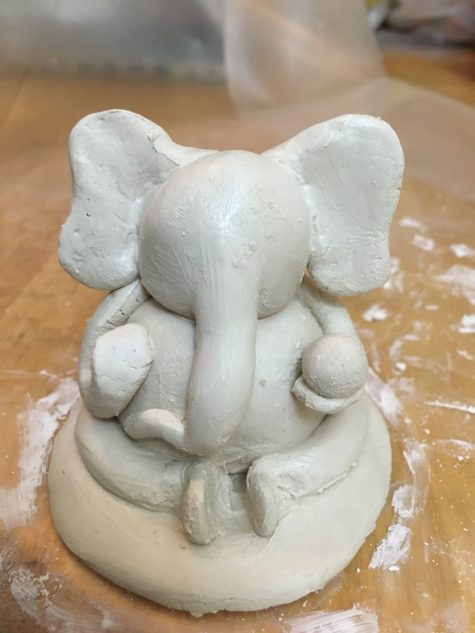 Instructions:
Instructions:
- Mix paper mache to a firm but homogeneously wet consistency.
- Make an armature (skeleton) of wood, Styrofoam, or similar material.
- Create the image by covering the armature with paper mache.
- Make implements for each hand and make sure they can be inserted and glued later when the image is dry
- Brush the exterior smooth with a wet brush.
- Let the image dry in a cool place, away from the sunlight. (Drying time is usually one month for every foot in height for a clay image, three weeks for paper mache.)
- When dry, sand with coarse, then fine sandpaper
- Fill cracks with putty or joint compound.
- Sand again
- Apply a white primer and sand with very fine sandpaper.
- Make the image dust-free.
- Paint the torso, head, trunk, and limbs
- Use red paint and a fine brush for the Aum, swastika, and other – symbols.
- Paint, decorate, and/or assemble the various implements
- Place appropriate dress (traditionally white or red silk) upon the image.
- Glue the implements into the hands
- Decorate the image with ornaments, flowers, etc.
adapted from Loving Ganesa
by Satguru Sivaya Subramuniyaswami
An alternative method can be explored with this visual tutorial from Hobby Ideas:
How Ganesh Came Into Being
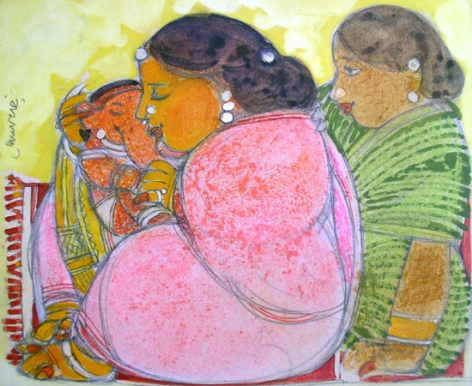
The legend behind the birth of Ganesha is as follows:
It is said that Goddess Parvati, before taking an elaborate bath, wanted someone to stand guard at the door.
Not finding anyone, she created the idol of a child from the sandalwood paste that she had applied on herself, and breathed life into it. She told the boy she had created not to let anyone in, and went to have her bath. When her husband, Lord Shiva came home, the child could not recognise him and refused to let him in. Shiva was furious, and severed the head of the child.
When she learnt that the child she had created was dead, Parvati was distraught and asked Shiva to revive him immediately. Shiva ordered his lieutenants to get the head of any creature that was sleeping with its head facing north. The servants returned with the head of an elephant. Shiva joined the elephant’s head to the boy’s body, and Parvati’s child lived again.
The legend also says that Shiva made the boy the leader of his armies. Hence, the name Ganesha, meaning ‘god of the army’.
Ganesh Maha Mantra
This video is a humble offering at the feet of our Lord Ganesh.
Ganesh Maha Mantra:
Om Gam Ganapataye Namaha
Ganesha mantras are siddhi mantras. Each mantra contains certain specific powers of Lord Ganesha. When chanted with the proper pranayama (rhythmic breathing) and sincere devotion, they will yield good results. In general, Ganesha mantras will ward off all evil and bless the devotee with abundance, prudence and success. Evil spirits dare not enter the home or the mind of the devotee where Ganesha mantras are recited.
- Album – Sacred Morning Chants – Shri Ganesh
- Artist – Shankar Mahadevan
A Hymn To Ganesha
A Renowned Five-Jeweled Hymn by
Sri Adi Sankara (798-820)
Free-Flowing Translation by J. Sethuraman
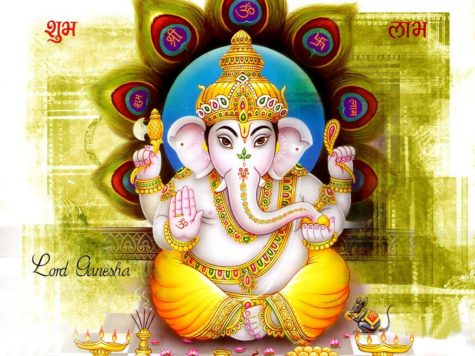
Maha Ganesa Pancharatna Stotram
I bow to Vinayaka
Who, with glee, holds a half-eaten modaka in His hand,
Who is the ever-present means of moksha
Who has the moon as an ear ornament,
Who protects all the worlds,
Who is the single leader for those who are lost without anybody to help them,
Who destroyed the elephant demon and
Who swiftly removes the blemishes of those who bow to Him.
I seek refuge of the great Lord Vinayaka
Who is higher than the highest,
Who is everlasting,
Who is ferocious to others than those that bow to Him,
Who is resplendent as the newly rising sun,
Worshiped by both demons and Gods,
The savior of those that bow to Him from all their miseries,
The lord of all the Gods,
The lord of all wealth,
The elephant God,
And Ganesvara, the lord of the ganas.
I bow to the resplendent one
Who bestows peace to all the worlds,
Who conquered the elephant demon,
Who has not a small belly,
The excellent one,
Who has a beautiful elephant face,
Who is eternal,
Who is kind,
Who is forgiving,
Who gives happiness,
Who bestows fame and
Who satisfies every wish of those that bow to him.
I worship the ancient elephant God
who shares the misery of the poor,
the fit receptacle of all the ancient prayers,
the first son of the enemy of the three cities (Shiva),
the shatterer of the pride of the demons,
the fierce destroyer of the worlds,
decorated by fire and other elements, and
whose elephant cheeks are flowing with must
(the rut that flows from the cheeks of male elephants.)
I constantly think of Him alone,
the single-tusked one,
With a lovingly brilliant tusk,
The son of the destroyer of the sacrifice (Shiva),
With a form that cannot be comprehended,
With no end,
Who tears asunder all doubts, and
Who is verily like spring to the yogis who hold Him in their hearts all the time.
One who repeats every day
The Maha Ganesha Pancharatna Stotram
With reverence
In the mornings or evenings
while holding Ganesvara in his heart
He, very quickly,
Will be joined by
Good health, blemishlessness, good fellowship, good children, long life,
and the eight vibhutis (powers).
from Loving Ganesa
by Satguru Sivaya Subramuniyaswami
How To Meditate
For the purpose of this project, we are recommending the “unstructured” meditation practice. In the “unstructured” meditation practice, we simply substitute the mantra for our normal mental chatter.
Whenever you feel angry, uncomfortable, unhappy, frustrated, upset, scared, bored, unsure, or unloved, simply begin to think (or say) the mantra. If you notice that you are dwelling on unpleasant experiences in the past, experiencing unhappiness in the present present or envisioning a disastrous future – just go back to thinking the mantra. Any time you find yourself in the grip of worry, guilt, or fear – this just means it’s time to begin thinking the mantra again. When you are driving in your car, when you are cleaning your house, when you are working out, when you begin a new task – these are all excellent times to remember the mantra.
Eventually, the mantra will be a constantly running stream in the background of your mind. Your “worry” thoughts will begin to take on less importance. It’s as if, when you wake up in the morning, you begin your meditation practice, and you continue it all day long until you go to bed. Anytime you notice “Oh, I am not thinking that mantra,” just begin it again.
The mantra may be said aloud, or sung, or chanted, or allowed to just run silently through your mind. It doesn’t matter at all. Whatever feels most comfortable for you at the time.
If you prefer a more structured practice, that’s fine too. Here are some guidelines you might find helpful:
Traditional meditation practice is called Japa, or recitation, and is the spiritual practice of devotedly repeating a mantra, generally a specified number of times, such as 108, often while counting on a strand of beads, called a japa mala, while conscientiously concentrating on the meaning of the mantra. The mantra can also be repeated for a specified period of time, such as 20 minutes. This can be done while sitting or walking, and gives the best results with a consistent daily practice.
The repetition should be dutifully slow. This brings punya, merit, to the devotee. Japa is a form of devotional worship, invocation, supplication, praise, adoration, meditation and direct, experiential communion.
Unless we are actually in a state of samadhi (total absorption), which is rare for most people, japa provides a means to disengage from our racing thoughts and our memories of the past — mostly the bad ones. The repetition of positive, uplifting, spiritual mantras over and over again lifts consciousness and causes the muladhara chakra to spin clockwise. We feel uplifted. Life does not look so bad, and neither does the past. A sense of forgiveness comes and the future looms bright. The past is forgiven and forgotten. Japam can be done by everyone.
Making A Shrine For Ganesh

Creating a home shrine is not difficult. The altar should be close to the floor if you plan to use it for puja and/or meditation. However when there are small children in the home it is often best to have it higher and out of reach.
For a Ganesha shrine, an image, or murti, of Lord Ganesha is placed at the center of the altar. A metal or stone image is best, but if not available there are two traditional alternatives:
- A framed picture, preferably with a sheet of copper on the back.
- A kumbha, which is a symbol of Ganesha made by placing a coconut on a brass pot of water with five mango leaves inserted between the coconut and the pot. The coconut should be husked but still have the fibers on the top.
Bathing the God’s image (murti) is a part of a puja and other ceremonies. For this, special arrangements may need to be made. Most simply, the murti may be placed in a deep tray to catch the water. After the bath, the tray is removed and the murti dried off, and then dressed and decorated.
Various items for the altar can include:
- Water cups and a small spoon for offering water
- A brass vessel of unbroken, uncooked rice mixed with enough turmeric to turn the rice yellow
- A tray or basket of freshly picked flowers (without stems) or loose flower petals
- A lamp
- Small metal bell
- Incense burner and a few sticks of incense
- Fresh fruit
- Radical Self Care Project Overview by shirleytwofeathers - No Comment
- Radical Self Care Image Gallery by shirleytwofeathers - No Comment
- It’s A Wrap by shirleytwofeathers - 3 Comments
- Something To Consider by shirleytwofeathers - 1 Comment
- Nurturing Your Precious Self by shirleytwofeathers - 3 Comments
me: Make Your Own Violet Fire
Abdulrahman: Money Chant – Very Fast
Shirley Twofeathers: It’s A Wrap
Daniel Knirs: It’s A Wrap
Shirley Twofeathers: It’s A Wrap

